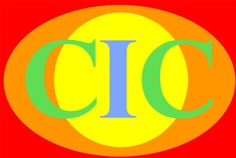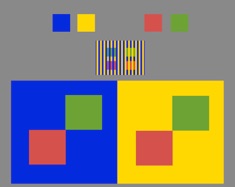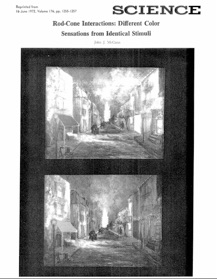Recent Papers
Color Assimilation and Contrast
near Absolute Threshold
Human light response spans more than 10 log units of dynamic range. That is the ratio of radiances from snow on a mountain top to human dark-adapted threshold. This range is possible because of retinal cells: rods (high sensitivity) and cones (daylight vision). There are many familiar spatial color experiments in which equal local stimuli make unequal appearances in daylight (Color Assimilation and Color Contrast). Since these experiments are the result of spatial processes, it is possible that the different anatomy and physiology of rods and cones could limit the range of these effects.
Remarkably, spatial effects at the lowest end of our visual HDR range are very similar to those at the top in sunlight. We found that color vision has consistent spatial behavior near absolute threshold and in bright sunlight. Our experiments show that Color Assimilation and Color Contrast behave the same using rod/Lcone color vision. Other achromatic Assimilation/Contrast experiments appeared similar over the entire HDR range of illumination. There were changes in sharpness and color hue, nevertheless, the spatial comparison process was remarkably constant, despite the well known changes in the anatomy and physiology of rods and cones.
Spatial interactions at the lowest end of our visual HDR range are very similar to those at the top of the range in sunlight. This is true for both chromatic and achromatic targets. Other of our control experiments indicate consistent behavior over the entire range. All of the tested spatial demonstrations gave "almost the same" observer responses over the HDR range of illumination. There were considerable changes in apparent sharpness associated with retinal inhomogeneity. There were changes in color hue due to changes in spectral sensitivity. However, the spatial comparison process was remarkably constant, despite the well known changes in the anatomy physiology of rods and cones.
Spatial interactions at the lowest end of our visual HDR range are very similar to those at the top of the range in sunlight. This is true for both chromatic and achromatic targets.
J. J. McCann,
“Color Assimilation and Contrast near Absolute Threshold”,
in Color Imaging XVII: Displaying, Processing, Hardcopy, and Applications, IS&T/SPIE, San Jose,
Proc. SPIE 8292,. 8292-2, (2012).
Appearance at the low-radiance end of HDR vision: Achromatic & Chromatic
Human vision spans more than 10 log units of dynamic range of light response. That is the ratio the radiance from snow on the top of a high mountain to the amount needed for dark adapted humans to see the light. This range is possible because of two types of retinal cells; rods (high sensitivity) and cones(daylight vision). There are many familiar spatial experiments in which equal local stimuli make unequal appearances in daylight. This paper tests whether Simultaneous Contrast, Adelson's Tower, White's Effect, Checkerboard and Dungeon Illusions, Benary's Cross, Color Contrast and Color Assimilation behave the same using rod vision. Since these experiments are the result of spatial processes, it is possible that the different anatomy and physiology of rods and cones could limit the range of these effects. Remarkably, spatial effects at the lowest end of our visual HDR range are very similar to those at the top of the range in sunlight.
-
J.J. McCann,
“Appearance at the low-radiance end of HDR vision: Achromatic & Chromatic”,
Proc. IS&T/SID Color Imaging Conference, 19, 223-228 (2011).
Colors in Dim Illumination and Candlelight
A variety of papers have studied color at low-light levels in different illuminants. This paper reviews these results and adds new experiments using long-wave-rich illumination, appropriate for rod and long-wave cone interactions. The experimental results agree with and extend previous results. Since these experiments use illuminates more appropriate for rod-cone interactions they measure a much greater range of colors. They also provide new data that clarifies how the rod information interacts with the cone-cone color channels. Color appearances indicate rods share M- and S-color channels.
-
J.J. McCann, “Colors in Dim Illumination and Candlelight”,
in Proc. IS&T/SID Color Imaging Conference, Albuquerque,
vol. 15, 2007.
Rod – Lcone color matching in complex images
Rod and L-cone interactions generate color appearances. This paper measure these appearances in complex scenes above and below-M and S-cone thresholds. The test target was a ColorChecker viewed in tungsten light and 1 wax candle. Firelight is an ideal illuminant for Rod-Lcone color. The observers’ task was to adjust RGB digits in LCD computer display to match the appearance of the ColorChecker. With the tungsten illumination, above L-,M-,& S-cone thresholds, the L*a*b* values for the reflective ColorChecker and the emissive LCD were reasonably close. With 1 candle illumination, the below M- and S-cone threshold ColorChecker showed matches marked different in L*a*b* values. A 4-D color space is not required because all colors were matched to above cone threshold colors, sharing information with other color channels. The color appearances are not consistent with rods sharing S-channel alone, or M-channel alone. The colors are not consistent with the rods desaturating all three channels. Under these conditions, the colors are consistent with the rod spatial comparisons sharing both the M- and the S-cone channels.
J. J. McCann, “Rod – Lcone color matching in complex images”, in Perception ECVP Abstract Supplement, 2007.
Ideal Illuminants for Rod /L-Cone Color
Humans see multicolor complex images with illuminants that have very low amounts of 400 to 580 nm light when there is enough long-wave light greater than 590 nm. Interactions between rods and long-wave (L) cones generate these colors. They are observed when there is insufficient light for a threshold response from M- and S-cones. This paper measures the spectral emission of a wood fire and a wax candle and it compares these low-color temperature spectral radiant exitances with the sensitivities of rods and long-wave cones. The paper reviews some of the literature on the evolution of human cone pigments and the early use of fire by hominids.
J. J. McCann, “Ideal Illuminants for Rod /L-Cone Color”, in Electronic Imaging XI: Processing, Hardcopy, and Applications; R. Eschbach, G. Marcu; Eds., Proc. SPIE, 6058, 1-8, 2006.
Chronology of Papers (1969-2011)
J.J. McCann, and J. L. Benton,
" Interactions of the Long-Wave Cones and the Rods to Produce Color Sensations ",
J. opt. Soc. Am., 59, 103-107, 1969.
J.J. McCann,
" Rod-Cone Interactions: Different Color Sensations from Identical Stimuli ",
Science, 176, 1255-1257, 1972.
J.J. McCann,
" Human Color Perception ",
in Color Theory and Imaging Systems , 1-23,
Soc. Phot. Sci. & Eng., R. Eynard, ed. Washington, DC, 1973.
S. P. McKee , J. J. McCann, and J.L Benton ,
" Color Vision from Rod and Long-Wave Cone Interactions: Conditions in which Rods contribute to Multicolored Images ",
Vis. Research 17, 175-185, 1977.
J. L. Benton , and J. J. McCann,
" Variegated color sensations from rod-cone interactions: Flicker-fusion experiments ",
J. opt. Soc. Am. 67, 119-121, 1977.
J. J. McCann, J. L. Benton, S. P. McKee,
Red/White Projections and Rod-Lcone Color: An Annotated Bibliography,
J. Electron. Imaging 13, 8-14, 2004.
J. J. McCann, “Rod – Lcone color matching in complex images”, in Perception ECVP Abstract Supplement, 2007.
J. J. McCann, “Ideal Illuminants for Rod /L-Cone Color”, in Electronic Imaging XI: Processing, Hardcopy, and Applications; R. Eschbach, G. Marcu; Eds., Proc. SPIE, 6058, 1-8, 2006.
-
J.J. McCann, “Colors in Dim Illumination and Candlelight”, in Proc. IS&T/SID Color Imaging Conference, Albuquerque, vol. 15, 2007.
J. J. McCann,
“Appearance at the low-radiance end of HDR vision: Achromatic & Chromatic‚” Proc. IS&T/SID Color Imaging Conference, 19, 223-228 (2011).







